Emission Ratios and Diurnal Variability of Volatile Organic Compounds and Influence of Industrial Emissions in Two Texas Cities
Abstract
1. Introduction
2. Materials and Methods
2.1. Texas Study Sites
2.2. Mobile Air Quality Laboratory (MAQL2)
2.3. Instrumentation
2.4. Emission Ratio Using Linear Regression Fitting (LRF) Method
2.5. Emission Inventory
2.6. Conditional Probability Function (CPF)
2.7. O3 Production Efficiency (OPE)
3. Results and Discussion
3.1. Daily Trends in BTX and Select VOC
3.2. Determination of VOC Emission Ratios
3.3. Comparison with Emission Inventories
3.4. Atmospheric Implications
4. Conclusions
Author Contributions
Funding
Institutional Review Board Statement
Informed Consent Statement
Data Availability Statement
Acknowledgments
Conflicts of Interest
References
- Hallquist, M.; Wenger, J.C.; Baltensperger, U.; Rudich, Y.; Simpson, D.; Claeys, M.; Dommen, J.; Donahue, N.; George, C.; Goldstein, A. The formation, properties and impact of secondary organic aerosol: Current and emerging issues. Atmos. Chem. Phys. 2009, 9, 5155–5236. [Google Scholar] [CrossRef]
- Healy, R.M.; Sofowote, U.M.; Wang, J.M.; Chen, Q.; Todd, A. Spatially resolved source apportionment of industrial VOCs using a mobile monitoring platform. Atmosphere 2022, 13, 1722. [Google Scholar] [CrossRef]
- Jia, C.; Batterman, S.; Godwin, C. VOCs in industrial, urban and suburban neighborhoods, Part 1: Indoor and outdoor concentrations, variation, and risk drivers. Atmos. Environ. 2008, 42, 2083–2100. [Google Scholar] [CrossRef]
- Liggio, J.; Li, S.-M.; Hayden, K.; Taha, Y.M.; Stroud, C.; Darlington, A.; Drollette, B.D.; Gordon, M.; Lee, P.; Liu, P. Oil sands operations as a large source of secondary organic aerosols. Nature 2016, 534, 91–94. [Google Scholar] [CrossRef]
- Seinfeld, J.H.; Pandis, S.N. Atmospheric Chemistry and Physics: From Air Pollution to Climate Change; John Wiley & Sons: Hoboken, NJ, USA, 2016. [Google Scholar]
- Yao, D.; Li, C.; Niu, Q.; Gao, W.; Yu, H.; Yan, G.; Liu, J.; Cao, Z.; Wang, S.; Wang, Y. Characteristics of volatile organic compounds and their contribution to secondary organic aerosols during the high O3 period in a Central Industry City in China. Atmosphere 2022, 13, 1625. [Google Scholar] [CrossRef]
- US Census Bureau, City and Town Population Totals: 2010-2019. 2019. Available online: https://www.census.gov/data/tables/time-series/demo/popest/2010s-total-cities-and-towns.html (accessed on 15 April 2019).
- Caselli, M.; de Gennaro, G.; Marzocca, A.; Trizio, L.; Tutino, M. Assessment of the impact of the vehicular traffic on BTEX concentration in ring roads in urban areas of Bari (Italy). Chemosphere 2010, 81, 306–311. [Google Scholar] [CrossRef]
- Dantas, G.; Gorne, I.; da Silva, C.M.; Arbilla, G. Benzene, toluene, ethylbenzene and xylene (BTEX) concentrations in urban areas impacted by chemical and petrochemical industrial emissions. Bull. Environ. Contam. Toxicol. 2022, 108, 204–211. [Google Scholar] [CrossRef]
- Hoque, R.R.; Khillare, P.; Agarwal, T.; Shridhar, V.; Balachandran, S. Spatial and temporal variation of BTEX in the urban atmosphere of Delhi, India. Sci. Total Environ. 2008, 392, 30–40. [Google Scholar] [PubMed]
- Zalel, A.; Broday, D.M. Revealing source signatures in ambient BTEX concentrations. Environ. Pollut. 2008, 156, 553–562. [Google Scholar] [CrossRef]
- Kim, S.-W.; McKeen, S.; Frost, G.; Lee, S.-H.; Trainer, M.; Richter, A.; Angevine, W.; Atlas, E.; Bianco, L.; Boersma, K. Evaluations of NOx and highly reactive VOC emission inventories in Texas and their implications for ozone plume simulations during the Texas Air Quality Study 2006. Atmos. Chem. Phys. 2011, 11, 11361–11386. [Google Scholar] [CrossRef]
- Guo, F.; Bui, A.A.; Schulze, B.C.; Yoon, S.; Shrestha, S.; Wallace, H.W.; Sakai, Y.; Actkinson, B.W.; Erickson, M.H.; Alvarez, S. Urban core-downwind differences and relationships related to ozone production in a major urban area in Texas. Atmos. Environ. 2021, 262, 118624. [Google Scholar] [CrossRef]
- Shrestha, S.; Yoon, S.; Erickson, M.H.; Guo, F.; Mehra, M.; Bui, A.A.; Schulze, B.C.; Kotsakis, A.; Daube, C.; Herndon, S.C. Traffic, transport, and vegetation drive VOC concentrations in a major urban area in Texas. Sci. Total Environ. 2022, 838, 155861. [Google Scholar] [CrossRef]
- Zhou, S.; Guo, F.; Chao, C.-Y.; Yoon, S.; Alvarez, S.L.; Shrestha, S.; Flynn III, J.H.; Usenko, S.; Sheesley, R.J.; Griffin, R.J. Marine submicron aerosols from the Gulf of Mexico: Polluted and acidic with rapid production of sulfate and organosulfates. Environ. Sci. Technol. 2023, 57, 5149–5159. [Google Scholar] [CrossRef] [PubMed]
- Buzcu, B.; Fraser, M.P. Source identification and apportionment of volatile organic compounds in Houston, TX. Atmos. Environ. 2006, 40, 2385–2400. [Google Scholar] [CrossRef]
- Sadeghi, B.; Pouyaei, A.; Choi, Y.; Rappenglueck, B. Influence of seasonal variability on source characteristics of VOCs at Houston industrial area. Atmos. Environ. 2022, 277, 119077. [Google Scholar] [CrossRef]
- Zhao, W.; Hopke, P.K.; Karl, T. Source identification of volatile organic compounds in Houston, Texas. Environ. Sci. Technol. 2004, 38, 1338–1347. [Google Scholar] [CrossRef] [PubMed]
- Jobson, B.; Berkowitz, C.M.; Kuster, W.; Goldan, P.; Williams, E.; Fesenfeld, F.; Apel, E.; Karl, T.; Lonneman, W.A.; Riemer, D. Hydrocarbon source signatures in Houston, Texas: Influence of the petrochemical industry. J. Geophys. Res. Atmos. 2004, 109, D24305. [Google Scholar] [CrossRef]
- Legreid, G.; Lööv, J.B.; Staehelin, J.; Hueglin, C.; Hill, M.; Buchmann, B.; Prevot, A.S.; Reimann, S. Oxygenated volatile organic compounds (OVOCs) at an urban background site in Zürich (Europe): Seasonal variation and source allocation. Atmos. Environ. 2007, 41, 8409–8423. [Google Scholar] [CrossRef]
- Biesenthal, T.A.; Shepson, P.B. Observations of anthropogenic inputs of the isoprene oxidation products methyl vinyl ketone and methacrolein to the atmosphere. Geophys. Res. Lett. 1997, 24, 1375–1378. [Google Scholar] [CrossRef]
- Park, C.; Schade, G.W.; Boedeker, I. Characteristics of the flux of isoprene and its oxidation products in an urban area. J. Geophys. Res. Atmos. 2011, 116, D21303. [Google Scholar] [CrossRef]
- Borbon, A.; Gilman, J.; Kuster, W.; Grand, N.; Chevaillier, S.; Colomb, A.; Dolgorouky, C.; Gros, V.; Lopez, M.; Sarda-Esteve, R. Emission ratios of anthropogenic volatile organic compounds in northern mid-latitude megacities: Observations versus emission inventories in Los Angeles and Paris. J. Geophys. Res. Atmos. 2013, 118, 2041–2057. [Google Scholar] [CrossRef]
- de Gouw, J.D.; Gilman, J.; Kim, S.W.; Lerner, B.; Isaacman-VanWertz, G.; McDonald, B.; Warneke, C.; Kuster, W.; Lefer, B.; Griffith, S. Chemistry of volatile organic compounds in the Los Angeles basin: Nighttime removal of alkenes and determination of emission ratios. J. Geophys. Res. Atmos. 2017, 122, 11843–811861. [Google Scholar] [CrossRef]
- Apel, E.; Emmons, L.; Karl, T.; Flocke, F.; Hills, A.; Madronich, S.; Lee-Taylor, J.; Fried, A.; Weibring, P.; Walega, J. Chemical evolution of volatile organic compounds in the outflow of the Mexico City Metropolitan area. Atmos. Chem. Phys. 2010, 10, 2353–2375. [Google Scholar] [CrossRef]
- Berezina, E.; Moiseenko, K.; Vasileva, A.; Pankratova, N.; Skorokhod, A.; Belikov, I.; Belousov, V. Emission Ratios and Source Identification of VOCs in Moscow in 2019–2020. Atmosphere 2022, 13, 257. [Google Scholar] [CrossRef]
- Brito, J.; Wurm, F.; Yáñez-Serrano, A.M.; de Assunção, J.O.V.; Godoy, J.M.; Artaxo, P. Vehicular emission ratios of VOCs in a megacity impacted by extensive ethanol use: Results of ambient measurements in São Paulo, Brazil. Environ. Sci. Technol. 2015, 49, 11381–11387. [Google Scholar] [CrossRef] [PubMed]
- Sahu, L.; Yadav, R.; Pal, D. Source identification of VOCs at an urban site of western India: Effect of marathon events and anthropogenic emissions. J. Geophys. Res. Atmos. 2016, 121, 2416–2433. [Google Scholar] [CrossRef]
- Valach, A.; Langford, B.; Nemitz, E.; MacKenzie, A.; Hewitt, C. Concentrations of selected volatile organic compounds at kerbside and background sites in central London. Atmos. Environ. 2014, 95, 456–467. [Google Scholar] [CrossRef]
- Acton, W.J.F.; Huang, Z.; Davison, B.; Drysdale, W.S.; Fu, P.; Hollaway, M.; Langford, B.; Lee, J.; Liu, Y.; Metzger, S. Surface–atmosphere fluxes of volatile organic compounds in Beijing. Atmos. Chem. Phys. 2020, 20, 15101–15125. [Google Scholar] [CrossRef]
- Morino, Y.; Ohara, T.; Yokouchi, Y.; Ooki, A. Comprehensive source apportionment of volatile organic compounds using observational data, two receptor models, and an emission inventory in Tokyo metropolitan area. J. Geophys. Res. Atmos. 2011, 116, D02311. [Google Scholar] [CrossRef]
- Parrish, D.D.; Kuster, W.C.; Shao, M.; Yokouchi, Y.; Kondo, Y.; Goldan, P.D.; de Gouw, J.A.; Koike, M.; Shirai, T. Comparison of air pollutant emissions among mega-cities. Atmos. Environ. 2009, 43, 6435–6441. [Google Scholar] [CrossRef]
- Velasco, E.; Lamb, B.; Pressley, S.; Allwine, E.; Westberg, H.; Jobson, B.; Alexander, M.; Prazeller, P.; Molina, L.; Molina, M. Flux measurements of volatile organic compounds from an urban landscape. Geophys. Res. Lett. 2005, 32, L20802. [Google Scholar] [CrossRef]
- Warneke, C.; McKeen, S.; De Gouw, J.; Goldan, P.; Kuster, W.; Holloway, J.; Williams, E.; Lerner, B.; Parrish, D.; Trainer, M. Determination of urban volatile organic compound emission ratios and comparison with an emissions database. J. Geophys. Res. Atmos. 2007, 112, D10S47. [Google Scholar] [CrossRef]
- McDonald, B.C.; De Gouw, J.A.; Gilman, J.B.; Jathar, S.H.; Akherati, A.; Cappa, C.D.; Jimenez, J.L.; Lee-Taylor, J.; Hayes, P.L.; McKeen, S.A. Volatile chemical products emerging as largest petrochemical source of urban organic emissions. Science 2018, 359, 760–764. [Google Scholar] [CrossRef] [PubMed]
- Griffin, R.J.; Johnson, C.A.; Talbot, R.W.; Mao, H.; Russo, R.S.; Zhou, Y.; Sive, B.C. Quantification of ozone formation metrics at Thompson Farm during the New England Air Quality Study (NEAQS) 2002. J. Geophys. Res. Atmos. 2004, 109, D24302. [Google Scholar] [CrossRef]
- Sillman, S. The use of NO y, H2O2, and HNO3 as indicators for ozone-NO x-hydrocarbon sensitivity in urban locations. J. Geophys. Res. Atmos. 1995, 100, 14175–14188. [Google Scholar] [CrossRef]
- Sun, Y.; Wang, L.; Wang, Y.; Zhang, D.; Quan, L.; Jinyuan, X. In situ measurements of NO, NO2, NOy, and O3 in Dinghushan (112° E, 23° N), China during autumn 2008. Atmos. Environ. 2010, 44, 2079–2088. [Google Scholar] [CrossRef]
- de Gouw, J.; Warneke, C. Measurements of volatile organic compounds in the earth’s atmosphere using proton-transfer-reaction mass spectrometry. Mass Spectrom. Rev. 2007, 26, 223–257. [Google Scholar] [CrossRef]
- Lindinger, W.; Hansel, A.; Jordan, A. On-line monitoring of volatile organic compounds at pptv levels by means of proton-transfer-reaction mass spectrometry (PTR-MS)—Medical applications, food control and environmental research. Int. J. Mass Spectrom. Ion Process. 1998, 173, 191–241. [Google Scholar] [CrossRef]
- Jobson, B.T.; McCoskey, J.K. Sample drying to improve HCHO measurements by PTR-MS instruments: Laboratory and field measurements. Atmos. Chem. Phys. 2010, 10, 1821–1835. [Google Scholar] [CrossRef]
- Parrish, D.; Ryerson, T.; Mellqvist, J.; Johansson, J.; Fried, A.; Richter, D.; Walega, J.; Washenfelder, R.D.; De Gouw, J.; Peischl, J. Primary and secondary sources of formaldehyde in urban atmospheres: Houston Texas region. Atmos. Chem. Phys. 2012, 12, 3273–3288. [Google Scholar] [CrossRef]
- de Gouw, J.; Middlebrook, A.; Warneke, C.; Goldan, P.; Kuster, W.; Roberts, J.; Fehsenfeld, F.; Worsnop, D.; Canagaratna, M.; Pszenny, A. Budget of organic carbon in a polluted atmosphere: Results from the New England Air Quality Study in 2002. J. Geophys. Res. Atmos. 2005, 110, D16305. [Google Scholar] [CrossRef]
- Sahu, L.; Tripathi, N.; Gupta, M.; Singh, V.; Yadav, R.; Patel, K. Impact of COVID-19 pandemic lockdown in ambient concentrations of aromatic volatile organic compounds in a metropolitan city of western India. J. Geophys. Res. Atmos. 2022, 127, e2022JD036628. [Google Scholar] [CrossRef]
- Texas A&M Transportation Institute. Final Report-2020 On-road mobile source annual, summer weekday, and winter weekday emissions inventories. 2022. Available online: https://www.tceq.texas.gov/downloads/air-quality/research/reports/on-road/5822111197019-20220425-tti-2020-aerr.pdf (accessed on 15 April 2023).
- Leuchner, M.; Rappenglück, B. VOC source–receptor relationships in Houston during TexAQS-II. Atmos. Environ. 2010, 44, 4056–4067. [Google Scholar] [CrossRef]
- Xie, Y.; Berkowitz, C.M. The use of positive matrix factorization with conditional probability functions in air quality studies: An application to hydrocarbon emissions in Houston, Texas. Atmos. Environ. 2006, 40, 3070–3091. [Google Scholar] [CrossRef]
- Pollack, I.B.; Ryerson, T.B.; Trainer, M.; Neuman, J.; Roberts, J.M.; Parrish, D.D. Trends in ozone, its precursors, and related secondary oxidation products in Los Angeles, California: A synthesis of measurements from 1960 to 2010. J. Geophys. Res. Atmos. 2013, 118, 5893–5911. [Google Scholar] [CrossRef]
- Trainer, M.; Parrish, D.; Buhr, M.; Norton, R.; Fehsenfeld, F.; Anlauf, K.; Bottenheim, J.; Tang, Y.; Wiebe, H.; Roberts, J. Correlation of ozone with NOy in photochemically aged air. J. Geophys. Res. Atmos. 1993, 98, 2917–2925. [Google Scholar] [CrossRef]
- Blanchard, C.L.; Hidy, G.M. Ozone response to emission reductions in the southeastern United States. Atmos. Chem. Phys. 2018, 18, 8183–8202. [Google Scholar] [CrossRef]
- Bon, D.; Ulbrich, I.; De Gouw, J.; Warneke, C.; Kuster, W.; Alexander, M.; Baker, A.; Beyersdorf, A.; Blake, D.; Fall, R. Measurements of volatile organic compounds at a suburban ground site (T1) in Mexico City during the MILAGRO 2006 campaign: Measurement comparison, emission ratios, and source attribution. Atmos. Chem. Phys. 2011, 11, 2399–2421. [Google Scholar] [CrossRef]
- Borbon, A.; Fontaine, H.; Veillerot, M.; Locoge, N.; Galloo, J.; Guillermo, R. An investigation into the traffic-related fraction of isoprene at an urban location. Atmos. Environ. 2001, 35, 3749–3760. [Google Scholar] [CrossRef]
- Drewitt, G.; Curren, K.; Steyn, D.; Gillespie, T.; Niki, H. Measurement of biogenic hydrocarbon emissions from vegetation in the Lower Fraser Valley, British Columbia. Atmos. Environ. 1998, 32, 3457–3466. [Google Scholar] [CrossRef]
- Jorquera, H.; Rappenglück, B. Receptor modeling of ambient VOC at Santiago, Chile. Atmos. Environ. 2004, 38, 4243–4263. [Google Scholar] [CrossRef]
- Buzcu-Guven, B.; Fraser, M.P. Comparison of VOC emissions inventory data with source apportionment results for Houston, TX. Atmos. Environ. 2008, 42, 5032–5043. [Google Scholar] [CrossRef]
- Anderson, D.C.; Pavelec, J.; Daube, C.; Herndon, S.C.; Knighton, W.; Lerner, B.M.; Roscioli, J.R.; Yacovitch, T.I.; Wood, E.C. Characterization of ozone production in San Antonio, Texas using observations of total peroxy radicals. Atmos. Chem. Phys. 2019, 19, 2845–2860. [Google Scholar] [CrossRef]
- Banta, R.; Senff, C.; Nielsen-Gammon, J.; Darby, L.; Ryerson, T.; Alvarez, R.; Sandberg, S.; Williams, E.; Trainer, M. A bad air day in Houston. Bull. Am. Meteorol. Soc. 2005, 86, 657–670. [Google Scholar] [CrossRef]
- Henderson, B.H.; Jeffries, H.E.; Kim, B.-U.; Vizuete, W.G. The influence of model resolution on ozone in industrial volatile organic compound plumes. J. Air Waste Manag. Assoc. 2010, 60, 1105–1117. [Google Scholar] [CrossRef]
- Kemball-Cook, S.; Parrish, D.; Ryerson, T.; Nopmongcol, U.; Johnson, J.; Tai, E.; Yarwood, G. Contributions of regional transport and local sources to ozone exceedances in Houston and Dallas: Comparison of results from a photochemical grid model to aircraft and surface measurements. J. Geophys. Res. Atmos. 2009, 114, D00F02. [Google Scholar] [CrossRef]
- Kleinman, L.I.; Daum, P.; Imre, D.; Lee, Y.N.; Nunnermacker, L.; Springston, S.; Weinstein-Lloyd, J.; Rudolph, J. Ozone production rate and hydrocarbon reactivity in 5 urban areas: A cause of high ozone concentration in Houston. Geophys. Res. Lett. 2002, 29, 105-1–105-4. [Google Scholar] [CrossRef]
- Nielsen-Gammon, J.; Tobin, J.; McNeel, A.; Li, G. A Conceptual Model for Eight-Hour Ozone Exceedances in Houston, Texas Part I: Background Ozone Levels in Eastern Texas. HARC/TERC/TCEQ Report. 2005. Available online: https://oaktrust.library.tamu.edu/handle/1969.1/158250 (accessed on 15 April 2023).
- Ryerson, T.; Trainer, M.; Angevine, W.; Brock, C.; Dissly, R.; Fehsenfeld, F.; Frost, G.; Goldan, P.; Holloway, J.; Hübler, G. Effect of petrochemical industrial emissions of reactive alkenes and NOx on tropospheric ozone formation in Houston, Texas. J. Geophys. Res. Atmos. 2003, 108, 4249. [Google Scholar] [CrossRef]
- Kotsakis, A.; Choi, Y.; Souri, A.H.; Jeon, W.; Flynn, J. Characterization of regional wind patterns using self-organizing maps: Impact on Dallas–Fort Worth long-term ozone trends. J. Appl. Meteorol. Climatol. 2019, 58, 757–772. [Google Scholar] [CrossRef]
- Bernier, C.; Wang, Y.; Estes, M.; Lei, R.; Jia, B.; Wang, S.C.; Sun, J. Clustering surface ozone diurnal cycles to understand the impact of circulation patterns in Houston, TX. J. Geophys. Res. Atmos. 2019, 124, 13457–13474. [Google Scholar] [CrossRef]
- Mazzuca, G.M.; Ren, X.; Loughner, C.P.; Estes, M.; Crawford, J.H.; Pickering, K.E.; Weinheimer, A.J.; Dickerson, R.R. Ozone production and its sensitivity to NOx and VOCs: Results from the DISCOVER-AQ field experiment, Houston 2013. Atmos. Chem. Phys. 2016, 16, 14463–14474. [Google Scholar] [CrossRef]
- Ren, X.; Van Duin, D.; Cazorla, M.; Chen, S.; Mao, J.; Zhang, L.; Brune, W.H.; Flynn, J.H.; Grossberg, N.; Lefer, B.L. Atmospheric oxidation chemistry and ozone production: Results from SHARP 2009 in Houston, Texas. J. Geophys. Res. Atmos. 2013, 118, 5770–5780. [Google Scholar] [CrossRef]
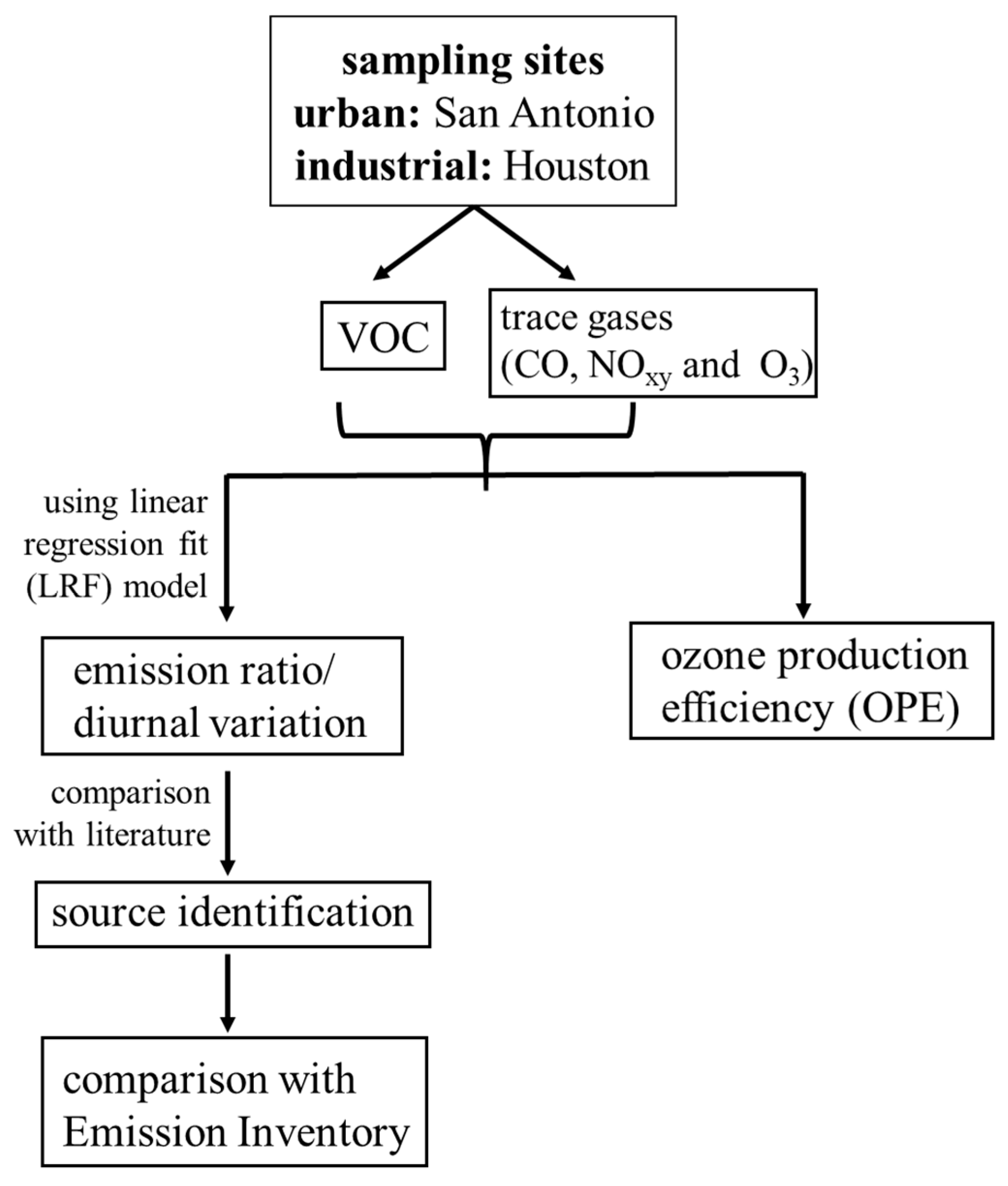
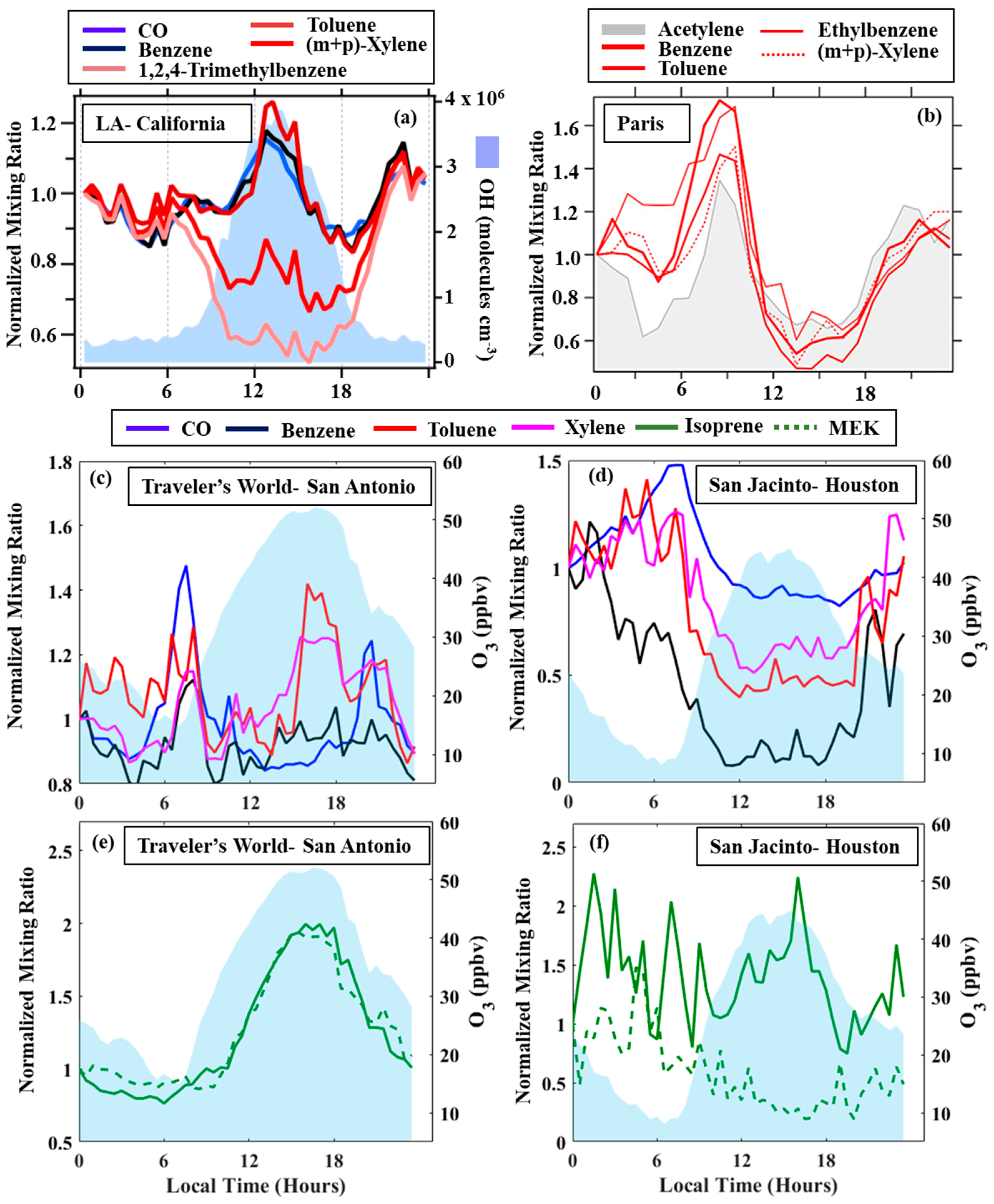
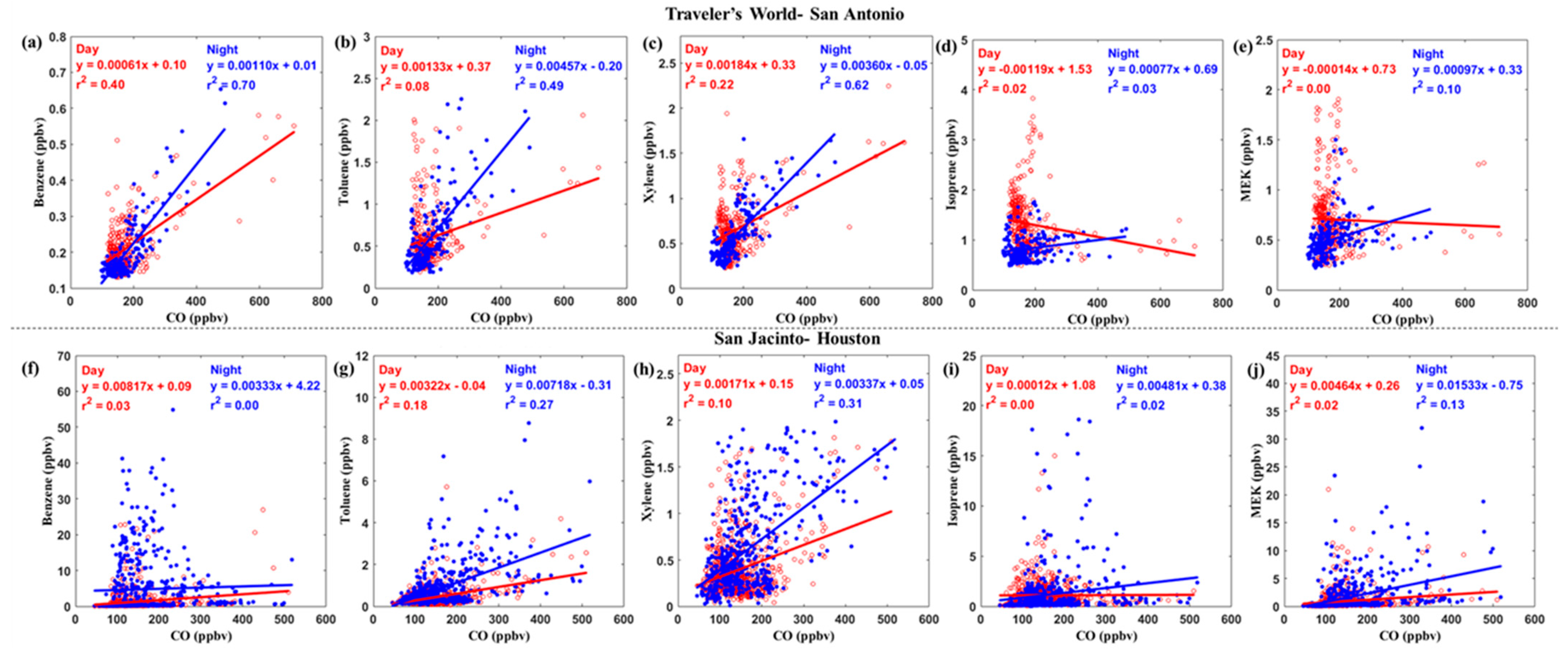
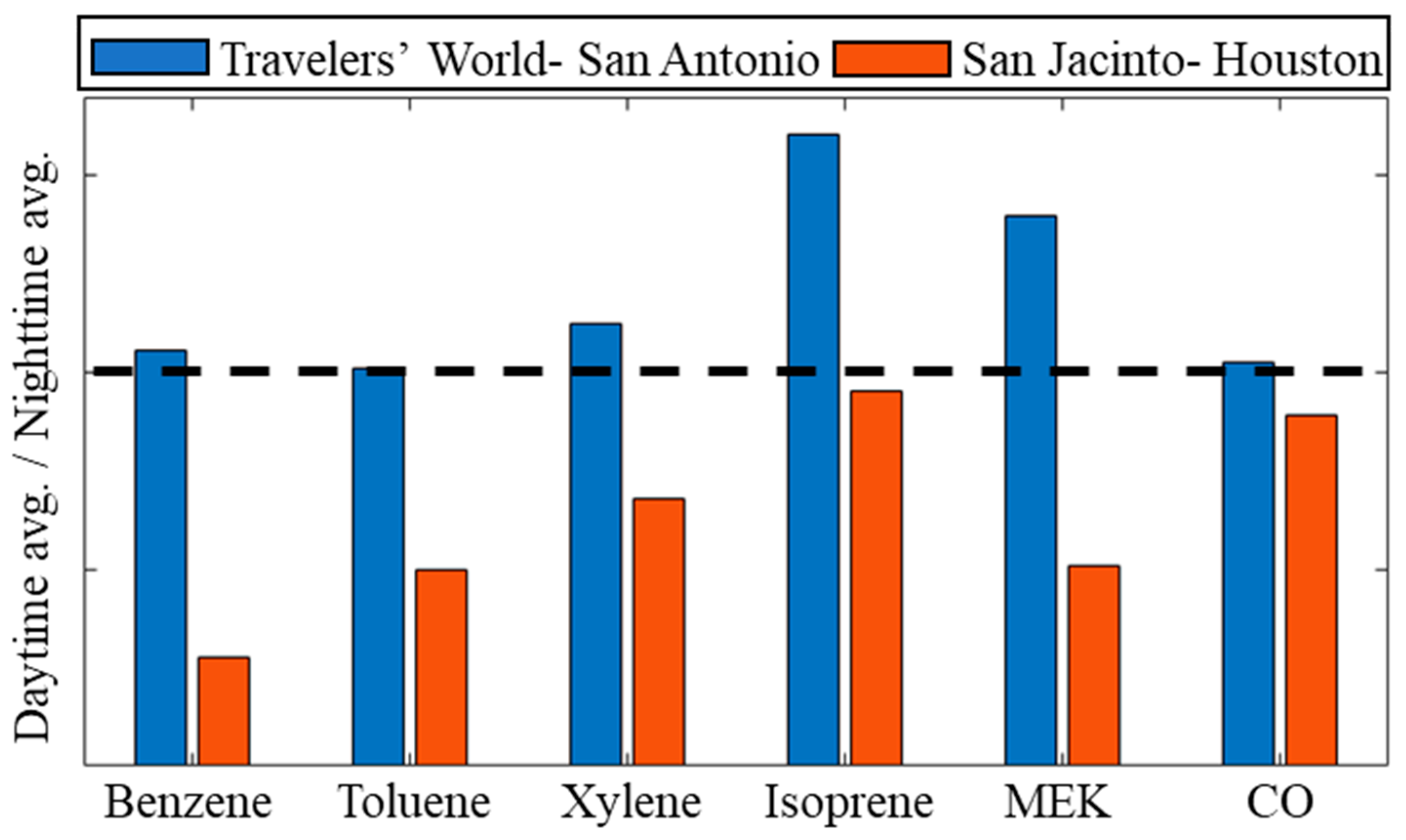
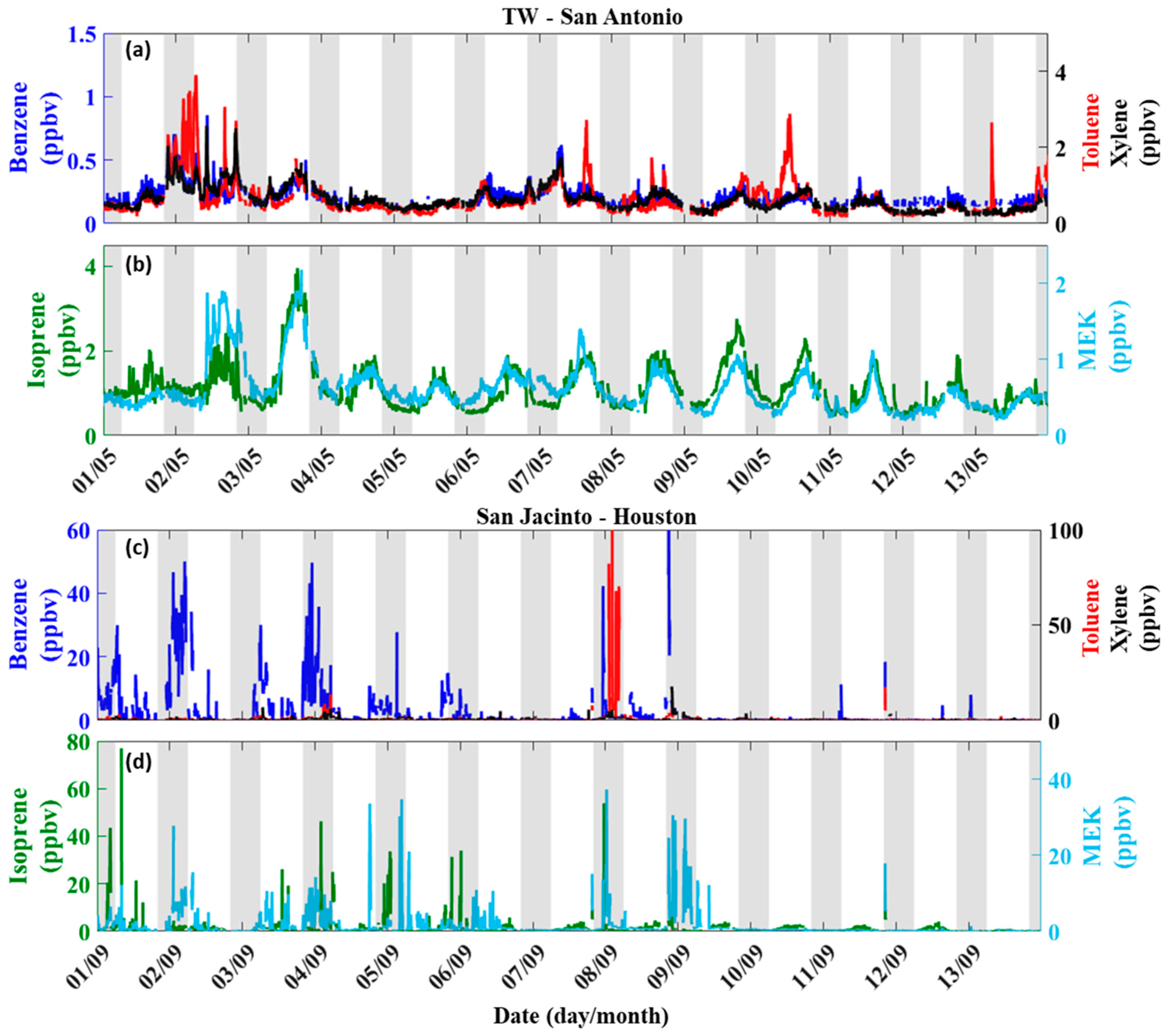
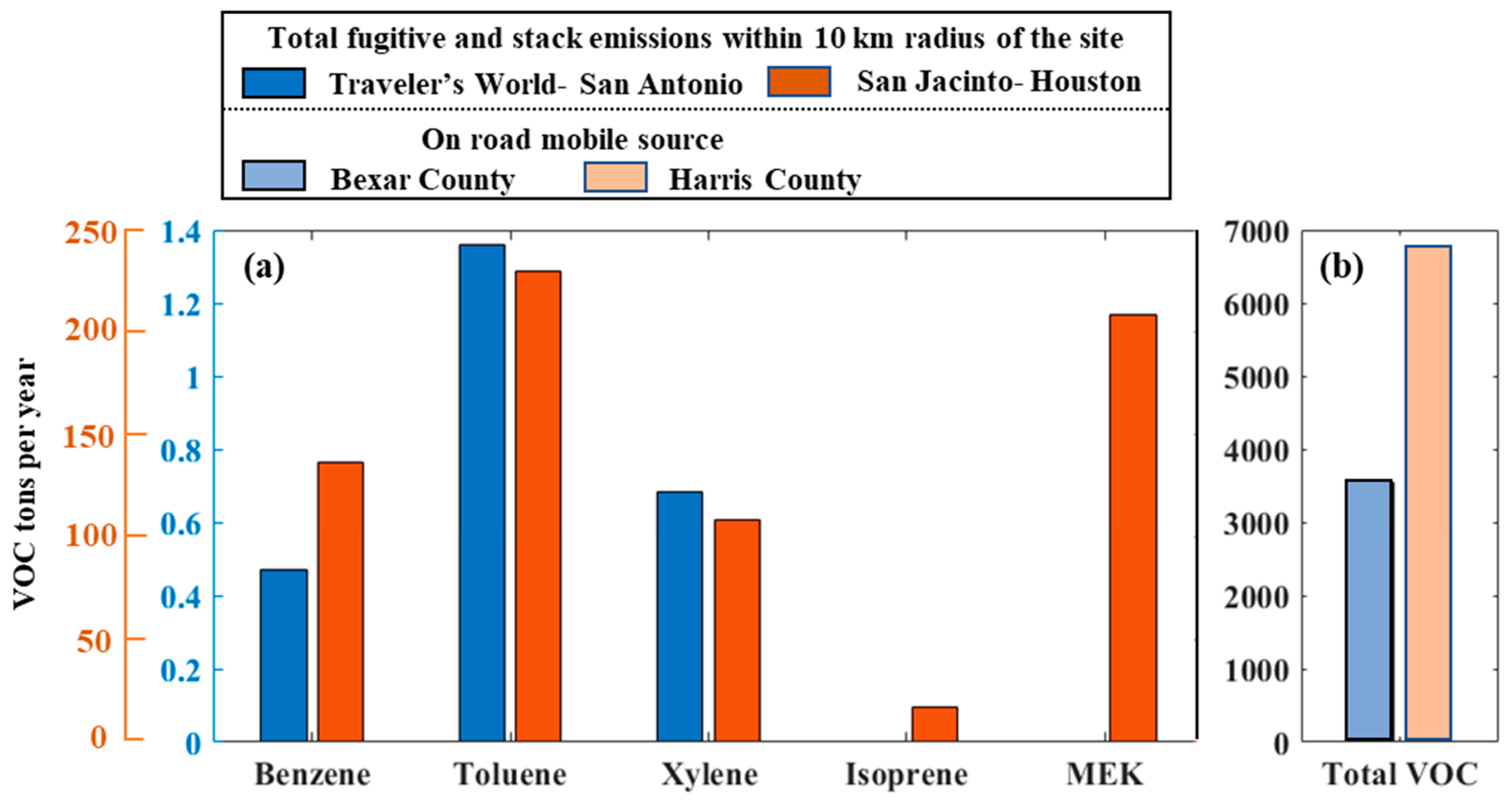
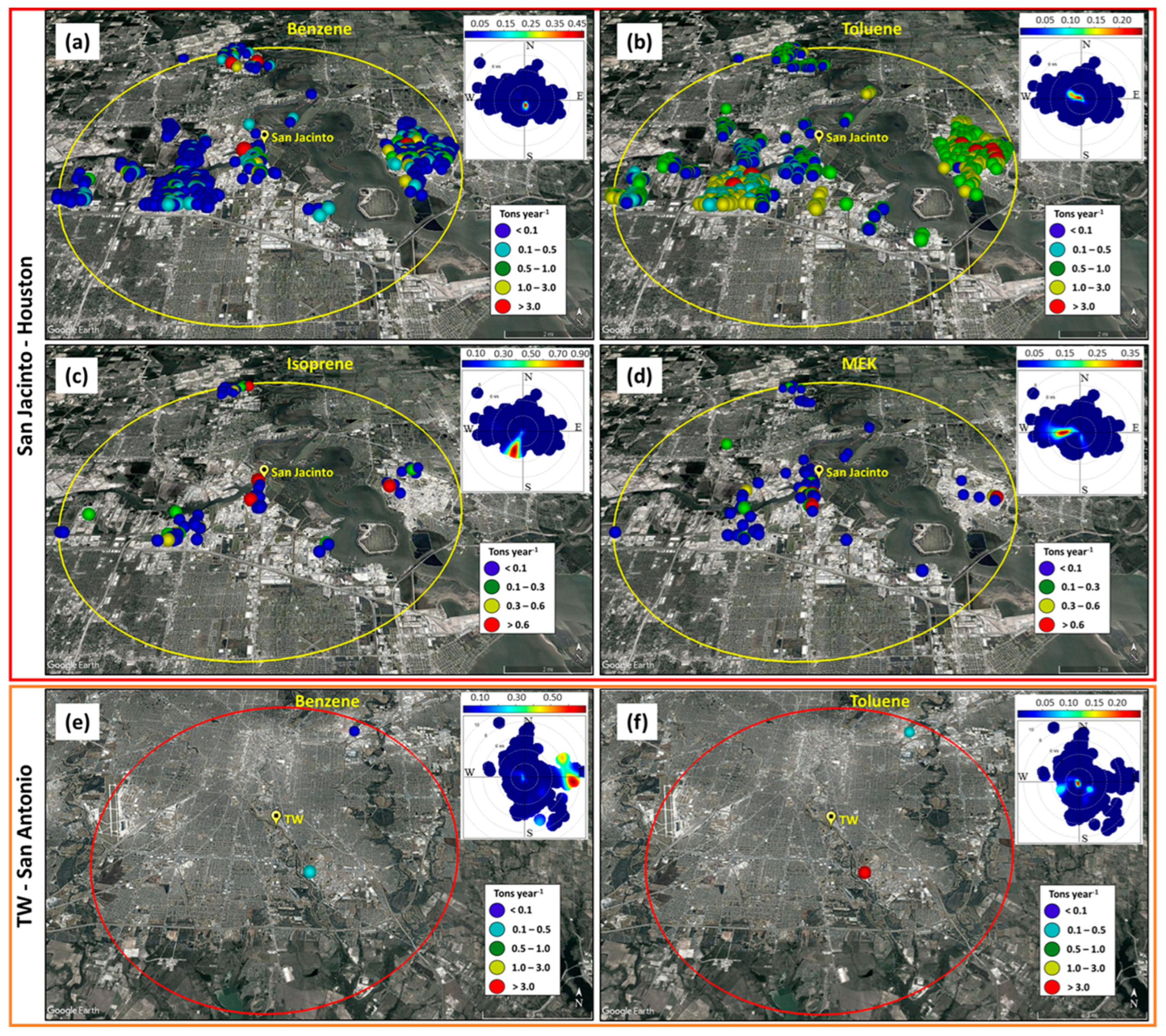
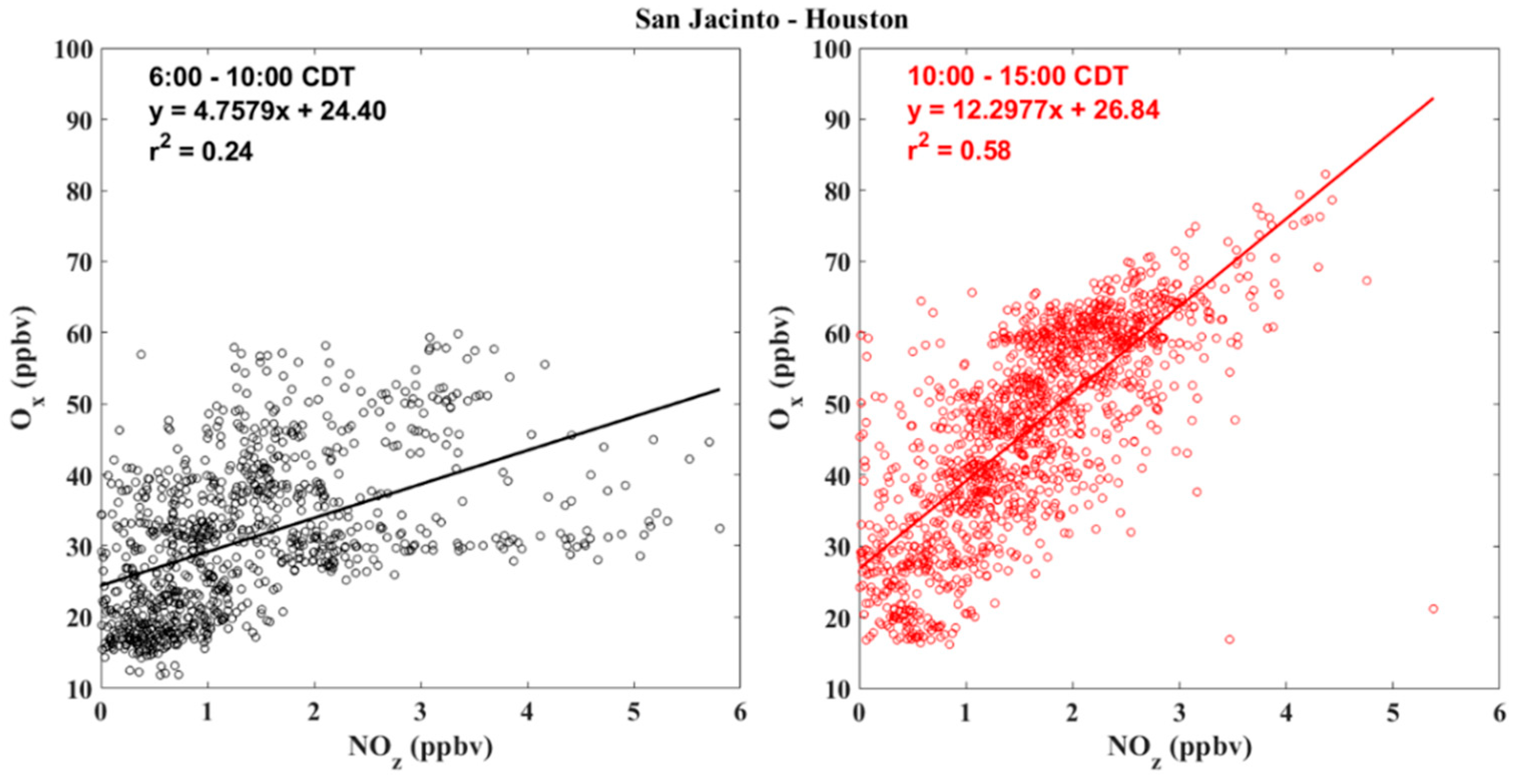
| VOC | ΔVOC/ΔCO (ppt/ppb) | ||||||||
|---|---|---|---|---|---|---|---|---|---|
| TW–San Antonio (r2) | San Jacinto–Houston (r2) | LA a | Paris a | Moscow b | Mexico City c | São Paulo d | London e | Ahmedabad f | |
| Benzene | 1.10 | 3.33 | 1.30 | 1.07 * | - | 1.21 | 1.03 | 1.59 | 1.00 |
| (0.70) | (0.00) | ||||||||
| Toluene | 4.57 | 7.18 | 3.18 | 12.3 * | 1.77 | 4.2 | 3.10 | 3.09 | 3.14 |
| (0.49) | (0.27) | ||||||||
| Xylene | 3.60 | 3.37 | 1.79 | 4.59 | 1.74 | 4.3 | 2.15 | 3.69 | - |
| (0.62) | (0.31) | ||||||||
| Isoprene | 0.77 | 4.81 | 0.30 | - | 0.17 | 0.08 g | 1.17 | 1.13 | 0.48 |
| (0.03) | (0.02) | ||||||||
| MEK | 0.97 | 15.33 | - | - | - | 0.29 | 1.42 | - | - |
| (0.10) | (0.13) | ||||||||
Disclaimer/Publisher’s Note: The statements, opinions and data contained in all publications are solely those of the individual author(s) and contributor(s) and not of MDPI and/or the editor(s). MDPI and/or the editor(s) disclaim responsibility for any injury to people or property resulting from any ideas, methods, instructions or products referred to in the content. |
© 2023 by the authors. Licensee MDPI, Basel, Switzerland. This article is an open access article distributed under the terms and conditions of the Creative Commons Attribution (CC BY) license (https://creativecommons.org/licenses/by/4.0/).
Share and Cite
Shrestha, S.; Yoon, S.; Alvarez, S.L.; Wang, Y.; Flynn, J.H.; Usenko, S.; Sheesley, R.J. Emission Ratios and Diurnal Variability of Volatile Organic Compounds and Influence of Industrial Emissions in Two Texas Cities. Atmosphere 2023, 14, 1006. https://doi.org/10.3390/atmos14061006
Shrestha S, Yoon S, Alvarez SL, Wang Y, Flynn JH, Usenko S, Sheesley RJ. Emission Ratios and Diurnal Variability of Volatile Organic Compounds and Influence of Industrial Emissions in Two Texas Cities. Atmosphere. 2023; 14(6):1006. https://doi.org/10.3390/atmos14061006
Chicago/Turabian StyleShrestha, Sujan, Subin Yoon, Sergio L. Alvarez, Yuxuan Wang, James H. Flynn, Sascha Usenko, and Rebecca J. Sheesley. 2023. "Emission Ratios and Diurnal Variability of Volatile Organic Compounds and Influence of Industrial Emissions in Two Texas Cities" Atmosphere 14, no. 6: 1006. https://doi.org/10.3390/atmos14061006
APA StyleShrestha, S., Yoon, S., Alvarez, S. L., Wang, Y., Flynn, J. H., Usenko, S., & Sheesley, R. J. (2023). Emission Ratios and Diurnal Variability of Volatile Organic Compounds and Influence of Industrial Emissions in Two Texas Cities. Atmosphere, 14(6), 1006. https://doi.org/10.3390/atmos14061006










